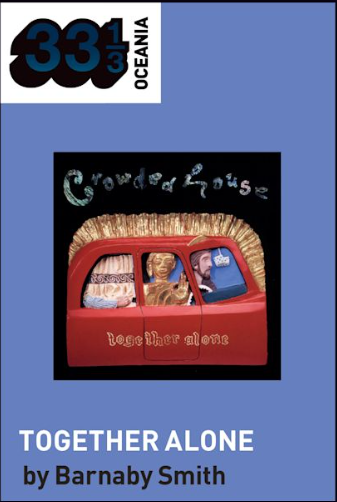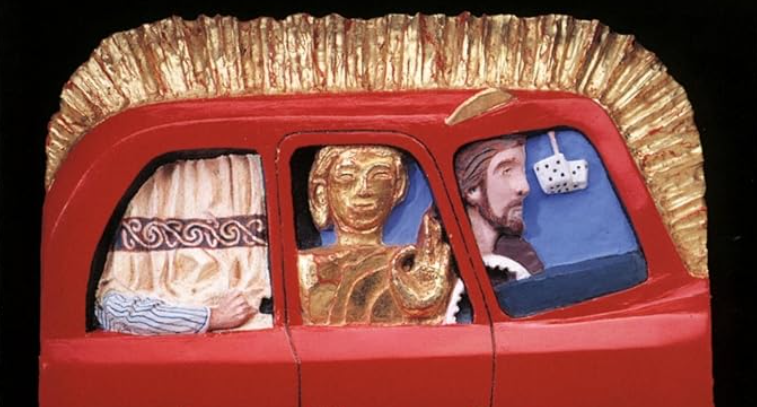Review: Together Alone (33 1/3 Oceania series), Barnaby Smith, Bloomsbury
Ask someone only mildly familiar with Crowded House to name their most prominent songs, and they would probably give you ‘Weather with You’ and ‘Don’t Dream It’s Over’; it is unlikely they would offer anything from 1993’s Together Alone. Indeed, Barnaby Smith recalls a journey home after a recent Crowded House concert when his fellow fans spontaneously erupted with an extended singalong session of Crowded House tunes, but without anything from Together Alone. Yet Together Alone remains probably the band’s most critically respected album. And, says Barnaby Smith, the story of its recording is the ‘most dramatic’.
The album was the first of theirs to be recorded in Aotearoa/New Zealand, near the beach of Karekare, near Auckland but a nevertheless rugged spot. Neil Finn had recently returned there to live, in the tradition of antipodean artists seeking fame in the northern hemisphere then being lured home by the sense of beauty and belonging.
It is easy to overstate the differences between Together Alone and its predecessor Woodface, which yielded a boatload of fan favourites – ‘Fall at your Feet’, ‘It’s Only Natural’, ‘Four Seasons in One Day’ – but the location made a difference. Smith indulges in some ‘psychogeography’, writing about how the location, as well as the application of some Māori tradition and mythology, influenced the album’s atmosphere – the summer evening feeling of ‘Private Universe’, for example, and the use of Māori choir and drummers on the title track, which Smith optimistically decides is a happy experiment.

After the glossier production of Woodface, English dance producer Youth was recruited. He brought out more of what Rolling Stone magazine, in their original review of Together Alone, called the ‘lurking melancholy’ within the band’s music. A little kooky and ‘pagan’, and more ‘coach’ than engineer, Youth encouraged the band to experiment more, but also not to overplay and to concentrate more on atmosphere. Bassist Nick Seymour relates how Youth encouraged him to restrain his usual ‘frilly’ busyness, notably on the last bars of ‘Nails in my Feet’, where he sits largely on one note, anchoring the guitars swirling around him but also adding heightened tension.
No-one except the parties involved assumed Youth’s involvement would work – and Finn has described how it wasn’t an entirely unqualified success – but Youth had a decent pop sensibility, evident in the variety of artists he had previously worked with. The result was that the slower songs were dreamier, the faster songs harder. There are moments of pop clarity and rich melodies, but also unexpected moments of brilliance – Smith offers sudden turns, messy outros and unidentifiable fleeting instrumental touches as examples. Smith adds that the album, more than its predecessors, is disorienting and full of longing that words don’t express adequately.
Smith suggests that the success of the songs is due to more than just their construction, and that may be true, but it is also due to Finn’s Beatle-esque way with chords and melodies. While always a clever songwriter, here Finn uses more complex chords and structures – the tension and resolve from using a jazz chord in ‘Nails in my Feet’, the way ‘Catherine Wheels’ changes to an almost-entirely different song half-way through, or the shifts from major to minor in ‘Walking on the Spot’, for example.
Finn likes a stream-of-consciousness style of lyric writing, letting phrases emerge from testing out words against melodies. His fractured lyrics play on themes but are not stories, in the sense that, say, Bob Dylan’s early songs are. Because the lyrics are akin to an abstract painting, Finn is reluctant, or perhaps unable, to deconstruct them, but Smith has a go at interpreting them anyway, in some cases enlightening us as to how they relate to the process and location of recording, and what was going on in the lives of the band members.
Although Crowded House had a public image of frivolity, Finn’s lyrics, unlike many of his pop music peers, had a mature complexity. As previously, here there are scenes of domesticity, though often with a sense of introspection or frustration and a Salvador Dali kind of surrealism – indeed, during ‘In My Command’ Finn sings of a clock ‘dripping on the wall’. There is mention of Persian rugs and kitchen sinks, and then the beautiful image of birds returning to the backyard palm tree at dusk on ‘Private Universe’.

Many of these songs were played at their ‘farewell’ concert at the Sydney Opera House in 1996, and they echoed the transcendence and bittersweet nature of the occasion beautifully. Of course, the departure would be short-lived, and Finn would reform the band, minus the late Paul Hester, but that’s another story. Finn has said that Together Alone is his favourite, at least of the albums from Mark I of the band, and that seems fair to me, but then not all fans would agree with him.
Nick Mattiske blogs on books at coburgreviewofbooks.wordpress.com and is the illustrator of Thoughts That Feel So Big.






